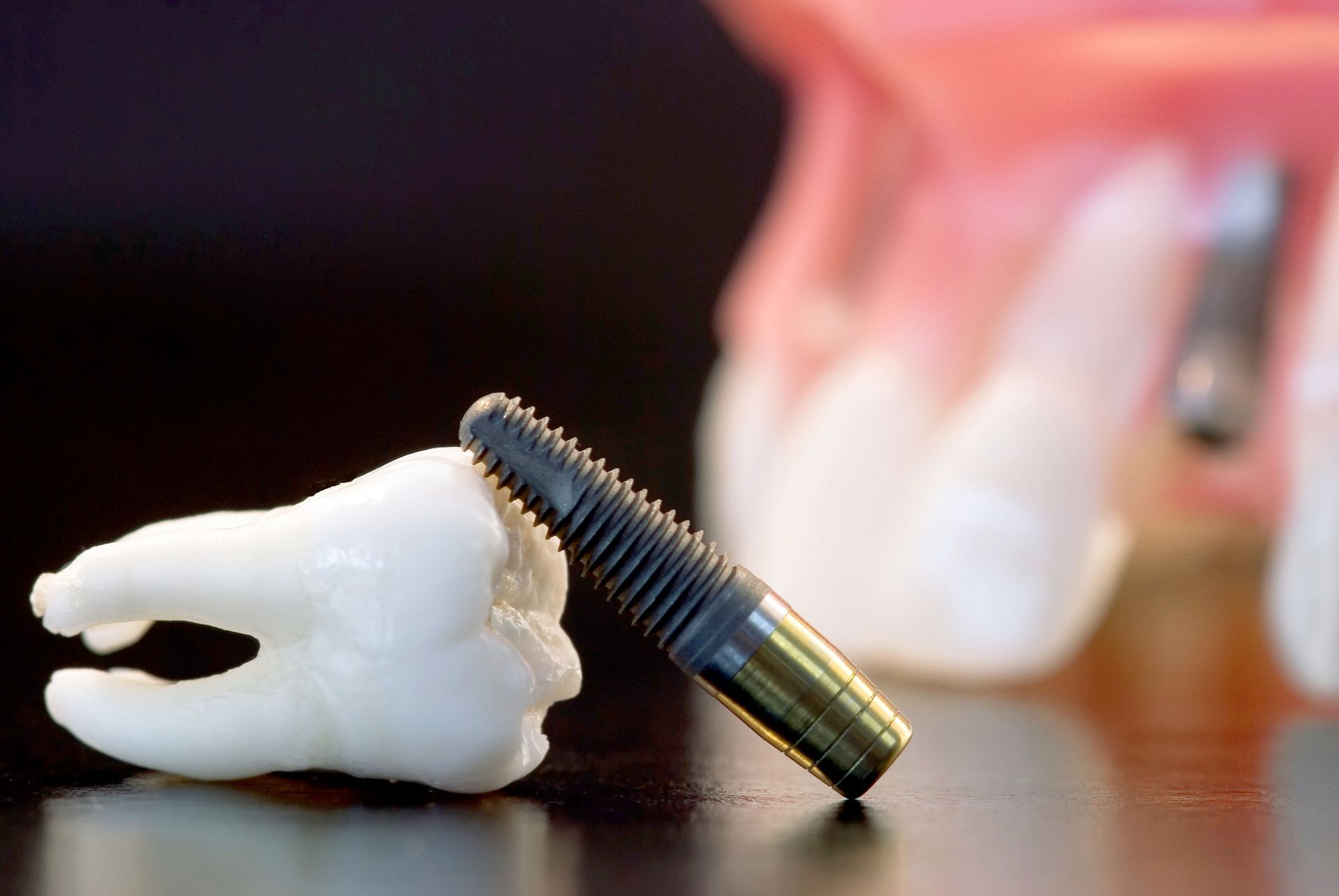November 10, 2025
A Dental implant is a remarkable advancement in dental care, offering a long-lasting solution for tooth loss. Periodontal disease, a chronic condition affecting the gums and supporting structures, can significantly impact oral health and the success of dental implant procedures. Men are more commonly affected by periodontal disease than women, with 56% of men experiencing the condition compared to 38% of women, according to Forbes. Understanding how periodontal disease interacts with dental implants is essential for making informed decisions about oral restoration and long-term health. With proper evaluation and treatment, patients can explore dental implants as a viable option for restoring their smile, function, and overall oral confidence.
Understand Periodontal Disease
Periodontal disease is a progressive inflammatory condition targeting the tissues surrounding the teeth. It begins as gingivitis, causing gum inflammation and bleeding, and can progress to periodontitis, where gums pull away from the teeth and bone loss occurs. Left untreated, it compromises the structural stability of teeth and can lead to tooth loss. Severity varies by individual and can be influenced by oral hygiene, genetics, and overall health. Regular monitoring and early intervention can prevent extensive damage and preserve oral structures for future dental procedures.
Identify Causes of Periodontal Disease
Plaque accumulation is the primary cause of periodontal disease. Poor oral hygiene allows plaque to harden into tartar, intensifying inflammation. Lifestyle factors such as smoking, poor diet, and stress also increase risk. Genetics plays a role, with some individuals more susceptible to gum disease despite diligent dental care. Hormonal changes, certain medications, and chronic illnesses can further exacerbate the condition. Awareness of these causes allows patients to take proactive steps in managing risk and maintaining healthy gums before considering a dental implant.
Recognize Symptoms of Periodontal Disease
Symptoms include red, swollen, or bleeding gums, receding gums, bad breath, loose teeth, and changes in bite. Early detection is crucial for intervention and preserving oral structures. Patients may notice discomfort when chewing or sensitivity to hot and cold foods. Periodontal evaluation by a dental professional can accurately determine disease progression and recommend targeted treatments to reduce inflammation and prevent further bone loss, ultimately improving candidacy for a dental implant.
Assess Periodontal Health
Diagnosis typically involves probing the gums to measure pocket depth, supplemented with radiographs to evaluate bone loss. Individual factors like medical history, smoking habits, and systemic conditions are considered to design effective treatment plans. Periodontal assessments help determine the appropriate timing for dental implants, ensuring that the mouth has sufficient healthy tissue and bone to support the implant successfully. Thorough evaluation minimizes complications and enhances the potential for long-term implant success.
Explore Dental Implants
A Dental implant is a titanium fixture surgically placed into the jawbone to replace missing teeth. They support crowns, bridges, or dentures, offering stability and function similar to natural teeth. Implants integrate with the bone through osseointegration, providing long-term durability, improved chewing, speech, and natural aesthetics. For patients who have lost teeth due to periodontal disease, implants restore oral function while preventing further bone deterioration, making them a reliable option for comprehensive dental rehabilitation.
Understand the Implant Procedure
The process begins with an evaluation of bone health and periodontal status. The implant is surgically placed into the jaw, allowed to heal, and then fitted with an abutment and prosthetic tooth. Each stage requires precise planning and collaboration with dental professionals to ensure stability and function. Healing time varies depending on individual health factors and bone density, but careful monitoring ensures the implant integrates successfully, providing a durable foundation for tooth replacement.
Appreciate the Benefits of Dental Implants
A Dental implant provides superior stability, preserves jawbone integrity, enhances chewing and speech, and improves appearance. Unlike traditional dentures, they prevent slippage and maintain facial structure. Patients experience increased confidence and long-term oral health benefits. Implants also help prevent adjacent teeth from shifting, maintaining proper bite alignment and promoting overall dental health. Their longevity makes them a cost-effective investment in restorative care.
Consider Limitations and Risks
While implants are highly successful, risks include infection, nerve injury, and peri-implantitis, particularly for patients with systemic conditions or heavy smoking habits. Proper assessment and ongoing care help reduce these risks, ensuring long-term results. Patients must follow post-operative care instructions closely and attend regular check-ups to prevent complications that could compromise implant stability.
Overcome Challenges in Implant Success
Active periodontal disease can impede implant integration due to infection, inflammation, and bone loss. Addressing gum health prior to surgery is essential to create a stable foundation for implants. Coordinated treatment plans between periodontists and implant dentists ensure that the gums and bone are sufficiently healthy to support dental implants, improving long-term outcomes and patient satisfaction.
Complete Treatment Prerequisites
Treatment may include root planning, surgery, or bone grafts to restore gum and bone health. Stabilizing periodontal disease ensures a higher likelihood of implant success and durability. Non-surgical and surgical treatments work together to prepare the oral environment, reducing inflammation and optimizing bone structure for the implant.
Manage Success Rates in Compromised Gums
With proper periodontal care, patients can achieve implant success rates similar to those with healthy gums. Consistent monitoring and maintenance are key to preserving implant stability and function. Studies show that with professional periodontal treatment, a dental implant can provide predictable, long-lasting results even for patients previously affected by advanced gum disease.
Utilize CT Scan Technology
CT scan technology has become an essential tool in modern dental implant planning and placement. By providing three-dimensional imaging of the jawbone and surrounding structures, CT scans allow dental professionals to assess bone density, identify nerve pathways, and determine optimal implant positioning. This level of precision ensures safer, more predictable outcomes, particularly for patients with a history of periodontal disease. With detailed imaging, dentists can plan bone grafts or sinus lifts when necessary and avoid potential complications during surgery. CT scans also facilitate the creation of customized surgical guides, allowing for accurate, minimally invasive procedures that promote faster healing and long-term implant success. By integrating CT imaging into the treatment process, patients benefit from enhanced safety, reduced risk of errors, and improved overall implant longevity.
Factor Individual Health Considerations
Systemic conditions such as diabetes or cardiovascular issues, and habits like smoking, affect candidacy and outcomes. Comprehensive evaluations and personalized treatment plans improve success rates and reduce complications. Maintaining general health, along with excellent oral hygiene, strengthens the potential for successful implant integration.
Employ Treatment Options Before Implant Placement
Root planing, surgery, bone grafts, and guided tissue regeneration address infection, inflammation, and bone loss. These treatments restore oral structures and prepare the mouth for a successful dental implant. Completing these interventions reduces the risk of implant failure and supports long-term stability.
Follow Immediate Post-Operative Care
Soft foods, pain management, and gentle oral hygiene are essential after surgery. Careful adherence to post-operative instructions promotes successful healing and integration. Patients may also be advised to avoid strenuous activity during the initial recovery phase to prevent complications and support bone integration.
Commit to Long-Term Maintenance
Routine dental visits, professional cleanings, and at-home care maintain implant health. Interdental brushes, water flossers, and dietary considerations further support longevity. Consistency in preventive care is critical for preserving both implants and the surrounding gum and bone tissue over the years.
Monitor for Complications
Signs of discomfort, swelling, or loosened implants require immediate professional attention. Infection can compromise outcomes without prompt intervention. Early detection and treatment of potential issues help sustain implant function and patient confidence.
Schedule Regular Check-Ups
Frequent evaluations assess implant integrity, gum health, and oral hygiene practices. These visits reinforce preventive care and ensure long-term success. They also provide an opportunity to adjust home care routines based on evolving oral health needs.
Empower Patient-Driven Care
Education on brushing, flossing, and communication with dental professionals fosters active participation in implant care. Patients play a crucial role in maintaining their restoration's longevity. Engaged patients tend to have better outcomes and higher satisfaction with their dental implant.
A Dental implant can be successfully achieved even in the presence of periodontal disease when gum health is properly managed and modern technologies are applied. Emphasizing individualized care, maintenance, and patient engagement fosters positive outcomes. At Harvey L Shuster DDS, we are committed to guiding patients through every stage of dental implant treatment, ensuring lasting results and restored smiles. Our team works closely with each patient to develop personalized plans and provide continuous support for long-term oral health.




